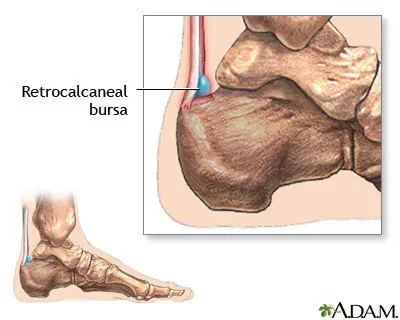
Retrocalcaneal Bursitis: When Is Achilles Tendinitis Not Achilles Tendinitis?
Do you experience pain at the back of your heel? Is the back of your heel red and swollen? Were you told that it Achilles Tendinitis? But so far treatment for Achilles Tendinitis does not seem to be working? You might be suffering instead from Retrocalcaneal Bursitis.
Background

Retrocalcaneal bursitis is the inflammation of the fluid-filled sac (bursa) at the back of the heel bone (calcaneus). The retrocalcaneal bursa is located between the Achilles tendon and the heel bone. It designed to reduce friction between the Achilles tendon and the heel bone.
During contraction of the calf muscle, tension is generated through the Achilles tendon and it rubs against the retrocalcaneal bursa. When there is excessive friction due to repetitive rubbing of the tendon against the bursa, or high impact force translating through the Achilles tendon, irritation and inflammation of the bursa may occur. Pressure can also aggravate the inflammation, such as when athletes wear tight-fitting shoes.
Often mistaken for Achilles tendinitis, this condition can also occur in conjunction with Achilles tendinitis.
Signs And Symptoms
In retrocalcaneal bursitis, pain at the back of the heel is the main complaint from patients. Pain may worsen when tip-toeing, running uphill, jumping or hopping. Those who accustomed to wearing high-heeled shoes on a long-term basis may also complain of pain at the back of the heel when switching to flat shoes.
This is because when in high-heeled shoes, the calf muscle and the Achilles tendon are in a shortened position. Switching to flat shoes would cause an increased stretch to the calf muscle and Achilles tendon. This would irritate the Achilles tendon and the retrocalcaneal bursa. Other symptoms may include redness and swelling at the back of the heel.
What Leads To Retrocalcaneal Bursitis?
There are several factors which can lead to a person developing retrocalcaneal bursitis. In athletes, especially runners, overtraining, sudden excessive increase in running mileage may lead to retrocalcaneal bursitis. Tight or ill-fitting shoes can be another causative factor as they can produce excessive pressure at the back of the heel due to restrictive heel counter.
Therefore, a person with an excessively prominent posterosuperior aspect of the heel bone (Haglund deformity) may also have a higher predisposition to retrocalcaneal bursitis. The pain would reproduce in such individuals when the ankle goes into dorsiflexion.
How Do We Tell That It Is Not Achilles Tendinitis?
Careful examination by your physician or physiotherapist can determine if the inflammation is from the Achilles tendon or from the retrocalcaneal bursa. Tenderness due to insertional Achilles tendinitis is normally located slightly more distal where the tendon inserts into the back of the heel. Tenderness caused by the retrocalcaneal bursa is normally palpable at the sides of the distal Achilles tendon.
An ultrasound investigation, MRI, or CT scan can confirm the diagnosis.
Management Of Retrocalcaneal Bursitis
- During the initial acute phase of the condition, patients should apply ice to the back of the heel for 15 to 20 minutes and follow the R.I.C.E.R regime. Avoid activities that cause pain.
- Gradual progressive stretching of the calf muscle and Achilles tendon is encouraged.
- Changing the footwear. Wearing an open-backed shoe may help relieve pressure on the affected region. This is especially for those whose symptoms caused by a sudden change from wearing high-heeled shoes to flat shoes. The temporary use of footwear with a heel height in between may be helpful.-
- Inserting a heel cup in the shoe may help to raise the inflamed region slightly above the shoe’s restricting heel counter and relieve the pain. It is advisable to also insert the heel cup into the other shoe to avoid any leg-leg discrepancies that can lead to other problems.
- Training frequency and intensity should gradually progress with adequate rest between training.
Experiencing foot pain? Find out more how Core Concepts Physiotherapy Singapore can help resolve your pain.
Related Articles
- Midportion Achilles Tendinopathy: Eccentric… Midportion Achilles Tendinopathy is one of the most common overuse injuries among recreational athletes with a prevalence of 11%. It…
- Trochanteric Bursitis Trochanteric bursitis is a common hip syndrome that causes pain and tenderness at the bony, outside point of the hip.…
- Achilles Tendinopathy Pain in the back of the heel is a very common complaint amongst athletes whose sports require quick, sudden movements.…
- Tendonitis and how to reload tendons safely In the last article, we covered what achilles tendinopathy is, why it occurs and how you can treat it.…
- How Do I Recover From My Achilles Pain? Most cases of Achilles pain that we see at our clinics have reached the tendinosis stage. In simple terms,…
